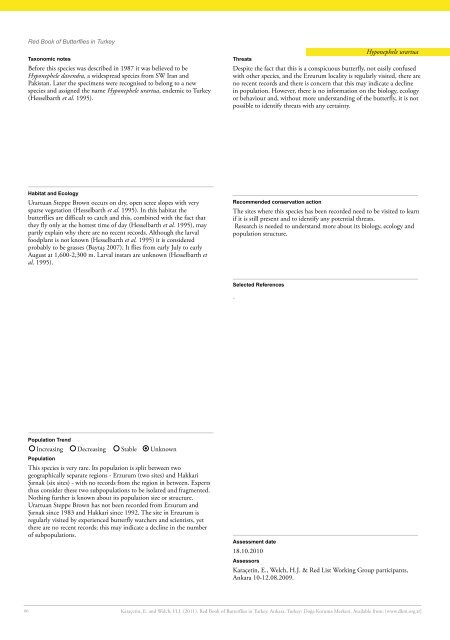Red Book of Butterflies in Turkey Red Book of Butterflies in Turkey
Red Book of Butterflies in Turkey Red Book of Butterflies in Turkey
Red Book of Butterflies in Turkey Red Book of Butterflies in Turkey
Create successful ePaper yourself
Turn your PDF publications into a flip-book with our unique Google optimized e-Paper software.
<strong>Red</strong> <strong>Book</strong> <strong>of</strong> <strong>Butterflies</strong> <strong>in</strong> <strong>Turkey</strong><br />
Taxonomic notes<br />
Before this species was described <strong>in</strong> 1987 it was believed to be<br />
Hyponephele davendra, a widespread species from SW Iran and<br />
Pakistan. Later the specimens were recognised to belong to a new<br />
species and assigned the name Hyponephele urartua, endemic to <strong>Turkey</strong><br />
(Hesselbarth et al. 1995).<br />
Habitat and Ecology<br />
Urartuan Steppe Brown occurs on dry, open scree slopes with very<br />
sparse vegetation (Hesselbarth et al. 1995). In this habitat the<br />
butterflies are difficult to catch and this, comb<strong>in</strong>ed with the fact that<br />
they fly only at the hottest time <strong>of</strong> day (Hesselbarth et al. 1995), may<br />
partly expla<strong>in</strong> why there are no recent records. Although the larval<br />
foodplant is not known (Hesselbarth et al. 1995) it is considered<br />
probably to be grasses (Baytaş 2007). It flies from early July to early<br />
August at 1,600-2,300 m. Larval <strong>in</strong>stars are unknown (Hesselbarth et<br />
al. 1995).<br />
Population Trend<br />
Increas<strong>in</strong>g Decreas<strong>in</strong>g Stable Unknown<br />
Population<br />
This species is very rare. Its population is split between two<br />
geographically separate regions - Erzurum (two sites) and Hakkari<br />
Şırnak (six sites) - with no records from the region <strong>in</strong> between. Experts<br />
thus consider these two subpopulations to be isolated and fragmented.<br />
Noth<strong>in</strong>g further is known about its population size or structure.<br />
Urartuan Steppe Brown has not been recorded from Erzurum and<br />
Şırnak s<strong>in</strong>ce 1983 and Hakkari s<strong>in</strong>ce 1992. The site <strong>in</strong> Erzurum is<br />
regularly visited by experienced butterfly watchers and scientists, yet<br />
there are no recent records; this may <strong>in</strong>dicate a decl<strong>in</strong>e <strong>in</strong> the number<br />
<strong>of</strong> subpopulations.<br />
66<br />
Hyponephele urartua<br />
Threats<br />
Despite the fact that this is a conspicuous butterfly, not easily confused<br />
with other species, and the Erzurum locality is regularly visited, there are<br />
no recent records and there is concern that this may <strong>in</strong>dicate a decl<strong>in</strong>e<br />
<strong>in</strong> population. However, there is no <strong>in</strong>formation on the biology, ecology<br />
or behaviour and, without more understand<strong>in</strong>g <strong>of</strong> the butterfly, it is not<br />
possible to identify threats with any certa<strong>in</strong>ty.<br />
Recommended conservation action<br />
The sites where this species has been recorded need to be visited to learn<br />
if it is still present and to identify any potential threats.<br />
Research is needed to understand more about its biology, ecology and<br />
population structure.<br />
Selected References<br />
-<br />
Assessment date<br />
18.10.2010<br />
Assessors<br />
Karaçet<strong>in</strong>, E., Welch, H.J. & <strong>Red</strong> List Work<strong>in</strong>g Group participants,<br />
Ankara 10-12.08.2009.<br />
Karaçet<strong>in</strong>, E. and Welch, H.J. (2011). <strong>Red</strong> <strong>Book</strong> <strong>of</strong> <strong>Butterflies</strong> <strong>in</strong> <strong>Turkey</strong>. Ankara, <strong>Turkey</strong>: Doğa Koruma Merkezi. Available from: [www.dkm.org.tr]


